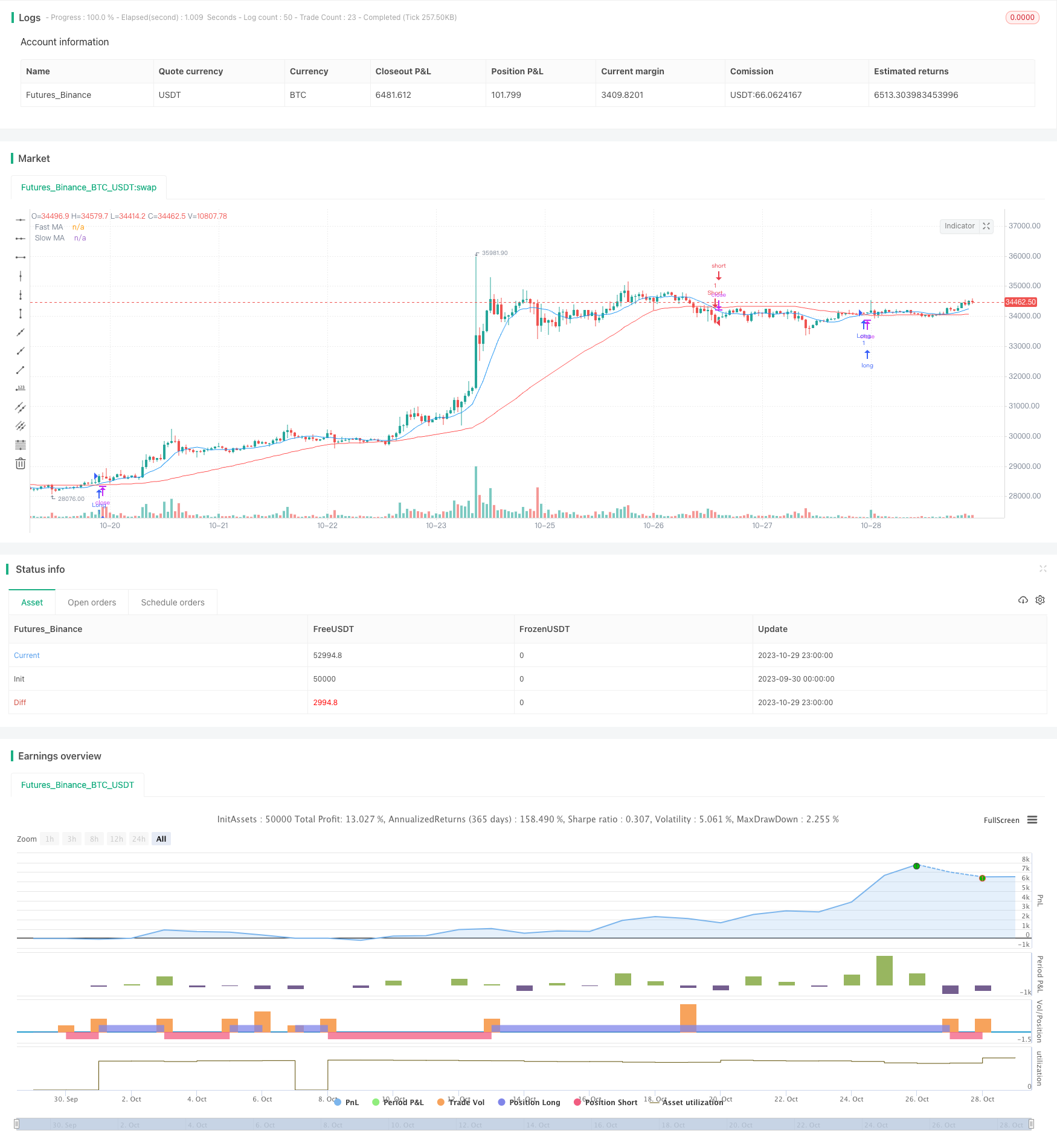
概述
双均线交叉策略是一种基于移动平均线的趋势跟踪策略。该策略通过计算不同周期的均线,判断市场趋势方向,以发出买入和卖出信号。本策略采用快速均线和慢速均线交叉形成交易信号。当快线上穿慢线时,采取看涨立场买入;当快线下穿慢线时,采取看跌立场卖出。
策略原理
本策略主要依靠均线交叉形成交易信号。具体来说,策略包含以下几个步骤:
计算快速均线和慢速均线。快速均线周期为10,慢速均线周期为50。
判断均线关系。当快速均线上穿慢速均线时,产生买入信号;当快速均线下穿慢速均线时,产生卖出信号。
发出买入卖出信号。产生买入信号时,进入多头仓位;产生卖出信号时,进入空头仓位。
设置止损止盈。交易入场后,根据输入的止损百分比设置止损位和止盈位,实现风险控制。
该策略通过比较不同时间周期价格趋势的变化,来判断市场目前处于上升趋势还是下降趋势,属于典型的趋势跟踪策略。由于均线能过滤市场噪音,使得交易信号更加可靠。
策略优势
- 利用均线的趋势跟踪特性,能够有效捕捉中长线趋势。
- 均线交叉信号简单清晰,容易执行。
- 可自定义快线和慢线的周期,优化参数组合。
- 采用止损止盈方式,可以限制个别订单的损失。
策略风险
- 当市场处于震荡态势时,容易产生频繁的交易信号,造成过度交易。
- 均线具有滞后性,可能错过短线机会。
- 未考虑突发事件的影响,如重大利空消息。
- 没有设置资金管理机制,容易造成超出风险承受能力的损失。
风险控制措施:
- 优化均线周期,减少震荡市场下的虚假信号。
- 结合其他指标作为过滤条件,避免均线滞后问题。
- 增加消息面分析作为辅助。
- 设置止损与持仓规模控制,控制单笔损失。
策略优化
可考虑将均线系统与其他分析工具组合使用,如通道、形态等,提高交易信号质量。
优化快线和慢线的参数,寻找最佳组合。一般快线周期在10到30天之间,慢线周期在20到120天之间会较好。
增加仓位管理机制。如采用固定比例递增法,能够在趋势中获得较优利润。
增加对突发事件的判断。重大利空消息发布时可考虑暂停交易,避免异常大亏损。
进行回测与模拟交易,评估策略表现,不断改进策略系统。
总结
双均线交叉策略通过比较快速均线和慢速均线的交叉情况,判断市场目前的趋势方向,属于简单实用的趋势跟踪策略。该策略优点是交易信号清晰、易于实现,但也存在一些局限性。我们可以通过参数优化、增加过滤条件、组合其他工具等方法来改进该策略,在控制风险的前提下获得更好的回报。
策略源码
/*backtest
start: 2023-09-30 00:00:00
end: 2023-10-30 00:00:00
period: 1h
basePeriod: 15m
exchanges: [{"eid":"Futures_Binance","currency":"BTC_USDT"}]
*/
//@version=4
strategy("Simple Moving Average Crossover", overlay=true)
// Input parameters
fast_length = input(10, title="Fast MA Length")
slow_length = input(50, title="Slow MA Length")
stop_loss_pct = input(1, title="Stop Loss Percentage", minval=0, maxval=5) / 100
// Calculate moving averages
fast_ma = sma(close, fast_length)
slow_ma = sma(close, slow_length)
// Plot moving averages
plot(fast_ma, color=color.blue, title="Fast MA")
plot(slow_ma, color=color.red, title="Slow MA")
// Strategy logic
long_condition = crossover(fast_ma, slow_ma)
short_condition = crossunder(fast_ma, slow_ma)
// Execute trades
if (long_condition)
strategy.entry("Long", strategy.long)
if (short_condition)
strategy.entry("Short", strategy.short)
// Set stop loss
long_stop_price = close * (1 - stop_loss_pct)
short_stop_price = close * (1 + stop_loss_pct)
strategy.exit("Stop Loss/Profit", from_entry="Long", stop=long_stop_price)
strategy.exit("Stop Loss/Profit", from_entry="Short", stop=short_stop_price)